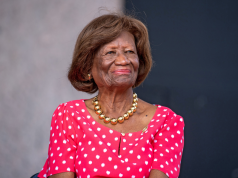 By M.L. JOHNSON, Associated Press
By M.L. JOHNSON, Associated Press
MILWAUKEE (AP) — The family of a Black man shot 14 times by a white police officer in a Milwaukee park marks the spot where he died with red spray paint before starting a rally and marching through city streets.
“Shame on you. People of color are people, too,” protesters chant while carrying signs declaring, “Black Lives Matter.”
The rallies are one way Dontre Hamilton’s family has kept his name in the news in the six months since his death. Smaller and more orderly than those in Ferguson, Missouri, the protests have not drawn national attention but have produced results. The man who shot Hamilton was fired, the first Milwaukee officer in decades to face such discipline in a fatal on-duty shooting.
Now the family wants more: criminal charges for the officer, and improvements in the way mentally ill people — Hamilton had schizophrenia — are treated by police and social service programs.
“They messed with the wrong family. … I’m not going to back down,” said Nate Hamilton, Dontre Hamilton’s brother.
Hamilton’s family participated in a vigil days after his April 30 death but then said little publicly as they waited out an investigation into the shooting. They wanted details about what happened and the officer disciplined. They were frustrated months later, when protests erupted in Ferguson following the shooting of a Black 18-year-old, Michael Brown, by a white officer.
“We tried to be accepting and respectful of the way the system works. … Until it got to the point where the Mike Brown thing happened,” Nate Hamilton said. “Now, you know who this police officer is, you’re seeing them get information, and in Milwaukee, we’re not getting no information.”
The family joined a Milwaukee demonstration organized to support those in Ferguson, and attention quickly focused on the similarities between the Brown and Hamilton cases. Nate Hamilton acknowledged some missteps, such as when protesters blocked a freeway exit ramp or became disruptive at a Police and Fire Commission meeting.
But overall, the protests have been peaceful, which Nate Hamilton said is crucial to building support for the family’s goals. While the protests have highlighted that Manney is white and Hamilton was Black, Hamilton’s family is focusing on broader issues, including mental health.
Police Chief Edward Flynn promised more training for officers dealing with people with mental illness and, on Oct. 15, fired Officer Christopher Manney for instigating the fight that led to the shooting. Manney has appealed.
Hamilton’s family wants to see Manney charged. The district attorney’s office has delayed a decision until it gets a recommendation from a national use-of-force expert.
The Hamiltons have been studying the law and police policy to better advocate for changes. They’re also finding other ways to channel their grief.
Hamilton’s mother is organizing a support group for women whose sons died in police shootings or custody and hopes to address shortcomings in mental health and social service programs. Maria Hamilton had struggled to get her 31-year-old son care after insurance problems caused him to miss his medication last winter. Until then, he had been doing well, living in group housing and working. Without the drugs, he became paranoid and began moving from place to place, eventually ending up in the park, where he was sleeping when Manney responded to a call from a nearby business about him.
“Had he had that medication, he might still be sitting here with us,” Maria Hamilton said.
Nate Hamilton and another brother, musician Dameion Perkins, wrote a song expressing their grief, anger and frustration. The song describes their “worst fear” — a brother “shot 14 times, didn’t do no wrong. Laying in the park, really I don’t see no harm. The investigation is still going on.”
Proceeds from the song sold on iTunes will benefit a foundation established in Hamilton’s memory.
“We can’t bring Dontre back,” Perkins said, “but what we can do is help somebody along the way.”
Perkins and Nate Hamilton remain bothered by police descriptions of their brother as homeless and violent. They describe Hamilton as fearful, but not dangerous. He checked into a hotel two days before the shooting and had almost $150 in cash on him when he died.
“He wasn’t dressed bummy, he was still dressed well, he had some Air Jordans on his feet … so we just felt like that was uncalled for,” said Nate Hamilton, who followed his brother into the roofing business before starting a remodeling company.
Maria Hamilton moved her sons from Gary, Indiana, to Milwaukee in 1995 to escape growing gang violence. She raised them to work hard, have faith and look out for one another. But Perkins said the shooting showed them that they had to be leaders.
“It’s taught us,” he said, “to use our minds on a broader scale.”



